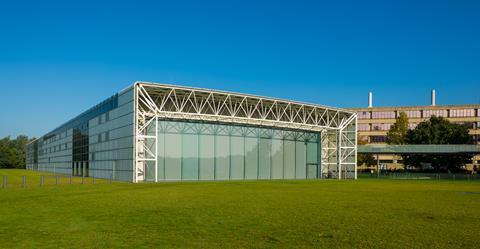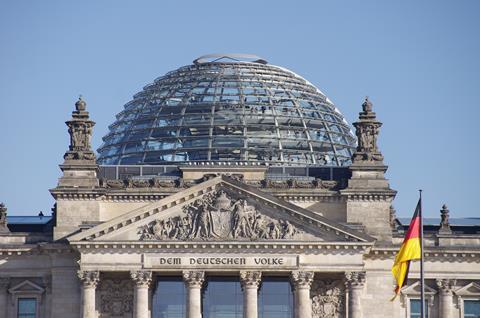Three-time Stirling Prize winner also describes shock revelation that drove resolve to study architecture

Norman Foster has named his practice’s Sainsbury Centre in Norwich and its refurbishment of the Reichstag in Berlin as the buildings he is most proud of in his 60-plus year career.
The three-time Stirling Prize winner set out his reasoning in an interview where he also discussed the surprising revelation that drove his resolve to become an architect.
Foster, who turned 87 in June, also dismissed the prospect of retirement in his interview for BBC Radio 4’s This Cultural Life programme. “Why should I? I enjoy what I do,” he said.
Asked to name the building or project he was proudest of, Foster – who is a father of five – likened the question to being asked to pick a favourite child.
“It is difficult,” he said. “If I had to take two buildings, then one would be the Sainsbury Centre, which was our first public building. It fused an extraordinary collection.”
The centre – properly known as the Sainsbury Centre for Visual Arts – was funded by Sir Robert and Lady Sainsbury to house their donation of ethnographic and 20th century art to the University of East Anglia.

Completed in 1978, the building is home to both gallery space and the university’s Faculty of Fine Art. Structural and service elements are contained within the building’s double-layer walls and roof.
“They discovered people like [Alberto] Giacometti, Francis Bacon, Henry Moore when he was an art teacher in Bradford,” Foster said of the Sainsburys.
“It was radical, and still is, to have a school of art history under the same roof as some of the greatest works of art on the planet.”
Foster said the Reichstag Building, refurbished and reimagined as the new home of the parliament of a reunited Germany in the 1990s, covered “so many different aspects” and delivered results significantly beyond the original brief.
“It is about public space. It is about ecology, it is about sustainability. It’s about reducing carbon footprint. It’s totally a mixture of solar, bio fuel. It’s a manifesto of sustainability, of a green-powered building,” he said.

“It’s also highly symbolic, and it brings the public symbolically above the politicians who are answerable to them and they embrace that and they embrace the idea of it being a green manifesto. But that was never part of what they asked for.”
The building is reputedly Germany’s second-most-visited attraction, after Koln Cathedral.
In the wide-ranging chat, Foster was asked about the defining aspect of his buildings. He responeded that it was “rooted in an optimistic belief that design can significantly improve the quality of life”, and was likely influenced by his past teachers.
He named Paul Rudolph, dean of architecture at Yale University – where Foster and Richard Rogers were studying on scholarships in the early 1960s, and Vincent Scully, art and architecture historian at the Ivy League college as key influences.
Foster cited “the impatience of Rudolph and a burning desire to create, to build, and to resist excuses of why something is not possible”, along with Scully’s “insight into the history of architecture and why the past is important in terms of informing the future”.
Le Corbusier and Frank Lloyd Wright
Foster also told This Cultural Life that as a teenager he had read and been influenced by Le Corbusier’s book Towards a New Architecture and a book about Frank Lloyd Wright by Henry-Russell Hitchcock, called In the Nature of Material, both of which he found in his local library.
Foster worked as an assistant to the contracts manager at Manchester-based practice John E Beardshaw & Partners after his National Service in the RAF, and described himself as “in awe” of the white-smock wearing staff who worked in the firm’s drawing office.
One day he plucked up courage to speak to the youngest member of the team, who was studying architecture part-time.
“Tell me, what do you think of Frank Lloyd Wright?” Foster said.
“He looked at me and said: ‘Is he studying down the road?’
“I looked back at him and I thought: ‘This guy doesn’t know who Frank Lloyd Wright is and he’s studying architecture’. I couldn’t believe it.”
He added: “That then really aroused my curiosity and it gave me the courage to go into the drawing office and be very open and say ‘How does one become an architect?’”
Foster had left school at 16 with only O levels, the forerunner to GCSEs. But he managed to put together a portfolio and secure a place on an architecture course, despite lacking the A levels required to study for a degree.
Practice opens Los Angeles Office
Foster & Partners has quietly opened a second office in California – bringing its portfolio of US bases to three, it emerged last week.
The new office at Venice Beach in Los Angeles is reportedly a base for just 12 staff – four from its San Francisco office, four from London and four new local hires. The practice also has an office in New York.
Senior partner and office lead Marc Guberman said the practice’s seafront LA base, understood to have opened in April, would not be a long-term outpost.
“It’s not our final step by any means,” he said.
Fosters has seen a growth in business in California off the back of its work on Apple Park in Silicon Valley.
Guberman added that the practice was carving out a distinct identity for its work in the Golden State.
“We made a strategic decision that Foster California would be 90% focused on California,” he said. “We live in the communities we’re building in. It’s a new way for a global practice to work.”
















No comments yet